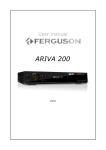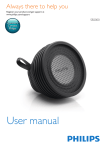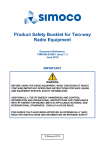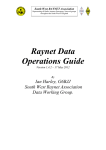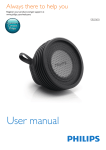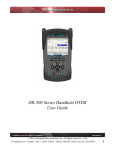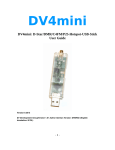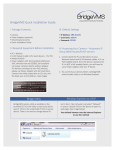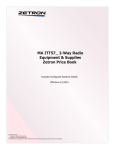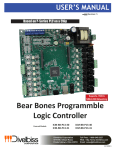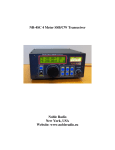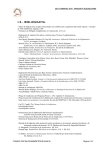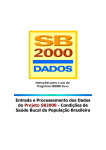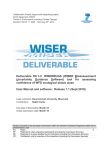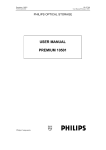Download DTS-Solar2 P25 Technical Information
Transcript
SOLAR 2 Simulcast over IP Synchronised (SOLAR 2 Sync) & Non-synchronised (SOLAR 2 Lite) P25 ADDENDUM to the TECHNICAL HANDBOOK AND USER MANUAL DTS-SOLAR 2-P25 Add Issue – 1.0 REVISION 1.0 DATE 18 May 11 PREPARED BY PJ APPROVED BO POSITION Dalman Technical Services Ltd. Field House, Uttoxeter Old Road Derby DE1 1NH Tel: +44 (0) 1332 375500 FAX: +44 (0) 1332 375501 http://www.teamsimoco.com Bid Eng. ©Simoco 2011 DTS-SOLAR 2-P25 Add PREFACE DECLARATION This Technical Manual Addendum covers the SOLAR 2 P25 equipment. It should be used in conjunction with the SOLAR 2 Technical Handbook and User Manual, Document Reference – DTS-SOLAR 2-TH, Issue 1.0. Any performance figures quoted are subject to normal manufacturing and service tolerances. The right is reserved to alter the equipment described in this manual in the light of future technical development. Changes or modifications not expressly approved by the party responsible for compliance could void the user’s authority to operate the equipment. NOTE. The manufacturer is not responsible for any radio or television interference caused by unauthorized modifications to this equipment. Such modifications could void the user’s authority to operate the equipment. CERTIFICATION AND APPROVALS (APPLYING TO THIS EQUIPMENT) This equipment is constructed to meet European Economic Community (EEC) Electromagnetic Compatibility (EMC) and Safety Directives. A sample equipment has been examined by a United Kingdom Accreditation Service (UKAS) testing organization and found to meet ETSI EN 301 489-1 and FCC 47 CFR parts 15.107 and 15.109. Federal Communications Commission (FCC) Part 15b information is available. COPYRIGHT This document contains information that is the intellectual property of Dalman Technical Services Limited (DTS). This information is for the use of the original purchaser of the equipment or their agents in the maintenance of the equipment discussed herein. All rights are reserved. This document may not, in whole or in part, be copied, photocopied, reproduced, translated, stored, or reduced to any electronic medium or machine-readable form, without prior written permission from DTS. DISCLAIMER There are no warranties extended or granted by this document. DTS accepts no responsibility for damage arising from use of the information contained in the document or of the equipment and software it describes. It is the responsibility of the user to ensure that use of such information, equipment and software complies with the laws, rules and regulations of the applicable jurisdictions. DOCUMENT CONTROL Application This document is intended for the use of suitably qualified engineers and technicians engaged in the installation and maintenance of the System. Equipment and Manual Updates In the interests of improving the performance, reliability or servicing of the equipment, DTS reserves the right to update the equipment or this document or both without prior notice. May 11 Page 2 PREFACE DTS-SOLAR 2-P25 Add ERRORS AND OMISSIONS The usefulness of this publication depends upon the accuracy and completeness of the information contained within it. Whilst every endeavour has been made to eliminate any errors, some may still exist. It is requested that any errors or omissions noted should be reported to: Dalman Technical Services Ltd Field House Uttoxeter Old Road Derby DE1 1NH UK Tel: +44 (0) 871 741 1050 E-mail: [email protected] DOCUMENT HISTORY Issue Date 1.0 May 2011 Comments Initial Issue. RELATED DOCUMENTS 1. DTS-SOLAR 2-TH. SOLAR 2 Simulcast over IP Synchronised (SOLAR 2 Sync) & Non-synchronised (SOLAR 2 Lite) – Technical Handbook and User Manual, Issue 1.0, dated 14 January 2011. 2. SGD-SB2000-TM. SB2000 Base Station, Repeater, Receiver and Transmitter – Technical Handbook, Issue 1.0, dated March 2011. 3. SGD-SR2000-TM. SR2000 Base Station, Repeater, Receiver and Transmitter – Technical Handbook, not yet Issued. May 11 Page 3 PREFACE DTS-SOLAR 2-P25 Add TABLE OF CONTENTS Page Title Page ...................................................................................................................................... 1 Preface .......................................................................................................................................... 2 Table of Contents (this list) ......................................................................................................... 4 List of Figures .............................................................................................................................. 6 List of Tables ................................................................................................................................ 6 PERSONAL SAFETY .................................................................................................................... 7 EQUIPMENT SAFETY ................................................................................................................... 8 WEEE Notice .............................................................................................................................. 10 General Notes ............................................................................................................................ 11 Support – Contact Information ................................................................................................. 12 Abbreviations ............................................................................................................................. 13 Glossary of Terms ..................................................................................................................... 15 1 INTRODUCTION ................................................................................................................. 16 1.1 SCOPE ............................................................................................................................. 16 1.2 BRIEF DESCRIPTION.......................................................................................................... 16 1.3 FUNCTIONAL DETAIL ................................................................................................... 18 1.3.1 Transmit Path (Central to Station) .......................................................................... 18 1.3.1.1 Analogue Transmit Mode .............................................................................. 18 1.3.1.2 P25 Transmit Mode....................................................................................... 18 1.3.2 Receive Path (Station to Central) ........................................................................... 19 1.3.2.1 Analogue Receive Mode ............................................................................... 19 1.3.2.2 P25 Receive Mode........................................................................................ 19 2 INSTALLATION .................................................................................................................. 21 2.1 SOLAR NI CONNECTORS ................................................................................................. 21 2.2 FACILITY CONNECTOR ...................................................................................................... 21 2.2.1 Audio Input (pins 1 & 10)........................................................................................ 21 2.2.2 Audio Output (pins 2 & 11) ..................................................................................... 22 2.2.3 Audio/C4FM Input (pin 3) ....................................................................................... 22 2.2.4 Audio/C4FM Output (pin 4) .................................................................................... 22 2.2.5 Analogue RSSI Input (pin 22)................................................................................. 22 2.2.6 Isolated Input #1 (pin 19)........................................................................................ 22 2.2.7 Isolated Input #2 (pin 20)........................................................................................ 22 2.2.8 Isolated Input #3 (pin 21)........................................................................................ 23 2.2.9 Relay #1 (pins 16 & 24).......................................................................................... 23 2.2.10 Relay #2 (pins 17 & 25).......................................................................................... 23 2.2.11 Relay #3 (pins 18 & 26).......................................................................................... 23 2.3 SB2000 CONNECTORS ..................................................................................................... 23 2.3.1 CN1 Line I/O Connector ......................................................................................... 23 2.3.2 CN2 Monitor Connector.......................................................................................... 24 2.4 SR2000 CONNECTORS ..................................................................................................... 24 May 11 Page 4 CONTENTS DTS-SOLAR 2-P25 Add 2.4.1 CN1 Line I/O Connector ......................................................................................... 24 3 ENGINEERING TERMINAL ................................................................................................ 25 3.1 GENERAL ......................................................................................................................... 25 3.2 STATION NETWORK INTERFACE ET.................................................................................... 25 3.2.1 Main Audio ............................................................................................................. 25 3.2.2 Signalling ............................................................................................................... 26 3.2.3 Facilities ................................................................................................................. 26 3.2.4 Environment........................................................................................................... 26 3.2.5 Handset.................................................................................................................. 26 3.3 CENTRAL NETWORK INTERFACE ET................................................................................... 27 3.4 TRAFFIC MANAGER ET ..................................................................................................... 27 3.4.1 Channel Setup ....................................................................................................... 27 3.4.1.1 Audio Mode................................................................................................... 27 3.4.1.2 P25 Channel Settings ................................................................................... 28 4 CONFIGURATION............................................................................................................... 29 4.1 STATION NI/SB2000......................................................................................................... 29 4.1.1 Tools, Test Equipment and Materials Required...................................................... 29 4.1.2 Procedure .............................................................................................................. 29 4.2 CENTRAL NI/AFSI ............................................................................................................ 37 APPENDICES A. SB2000 LINK SETTINGS FOR SOLAR P25 B. CONFIGURATION PROCEDURE CABLE REQUIREMENTS May 11 Page 5 CONTENTS DTS-SOLAR 2-P25 Add FIGURES Page Figure 1. SOLAR P25 Two Channel System – Basic Overview.................................................... 16 Figure 1. NI Engineering – Main Audio tab, new Audio Mode box................................................ 25 Figure 2. NI Engineering – Signalling tab, Signalling In box. ........................................................ 26 Figure 3. NI Engineering – Handset tab. ...................................................................................... 27 Figure 4. Channel Setup page – P25 tab. .................................................................................... 28 Figure 5. HyperTerminal – Menu.................................................................................................. 30 Figure 6. NI ET – Audio Mode to ‘Remote’. .................................................................................. 30 Figure 7. NI Engineering – Main Audio tab, “In Audio Sensitivity” settings.................................... 31 Figure 8. NI Engineering – Facilities tab, Test Tone Frequency. .................................................. 32 Figure 9. NI Engineering – Signalling tab, Manual Trigger. .......................................................... 32 Figure 10. MXTools – Channel Edit page..................................................................................... 33 Figure 11. Tx Modulation displayed on RTS................................................................................. 34 Figure 12. MXTools – Write Channel button................................................................................. 34 Figure 13. NI Engineering – Facilities tab, Test Tone settings...................................................... 35 Figure 14. Isolated Inputs and Outputs – Auto function. ............................................................... 37 Figure B1. T36 Module Serial Cable – wiring details. ................................................................... 39 TABLES Page Table 1. Table 2. Table 3. Table 4. Table 5. May 11 26-way high density D – NI Facilities I/O Sockets........................................................... 21 CN1 Line I/O Connector – 15-way D Socket. ................................................................. 24 CN2 Monitor Connector – 9-way D Socket. .................................................................... 24 CN1 Line I/O Connector – 15-way D Socket. ................................................................. 24 MXTools, Channel Edit Settings. .................................................................................... 33 Page 6 CONTENTS DTS-SOLAR 2-P25 Add PERSONAL SAFETY This equipment is designed and built to meet Safety and EMC requirements, adherence to these requirements may be compromised if the equipment is operated in a condition or manner which the design did not intend. Safety Precautions These Safety Precautions, Warnings and Cautions advise personnel of specific hazards which may be encountered during the procedures contained in this document and that control measures are required to prevent injury to personnel, and damage to equipment and/or the environment. Before commencing the installation or any maintenance of this equipment, personnel are to acquaint themselves with all risk assessments relevant to the work site and the task. They must then comply with the control measures detailed in those risk assessments. References covering safety regulations, health hazards and hazardous substances are detailed under the WARNINGS section below. These are referred to in the tasks, when encountered. Adequate precautions must be taken to ensure that other personnel do not activate any equipment that has been switched off for maintenance. Refer to the Electricity at Work regulations 1992. Where dangerous voltages are exposed during a task, safety personnel are to be provided as detailed in the Electricity at Work regulations 1992. Where safety personnel are required for any other reason, management are to ensure that the personnel detailed are aware of the hazard and are fully briefed on the action to be taken in an emergency. Where equipment contains heavy components or units that require lifting, lowering, pulling or pushing operations to be performed on them during maintenance tasks, all managers and tradesmen are to be conversant with the Manual Handling Operations Regulations 1992, ISBN 0110259203. Hazardous Substances Before using any hazardous substance or material, the user must be conversant with the safety precautions and first aid instructions: • On the label of the container in which it was supplied. • On the material Safety Data Sheet. • In any local Safety Orders and Regulations. WARNINGS Beryllium and Beryllia WARNING BERYLLIUM AND BERYLLIA. COMPONENTS AND SEMICONDUCTOR DEVICES CONTAINING BERYLLIUM OXIDE MAYBE USED IN THIS EQUIPMENT. REFER TO THE CONTROL OF SUBSTANCES HAZARDOUS TO HEALTH REGULATIONS (COSHH) 2002 AND/OR THE APPROPRIATE SAFETY DATA SHEET. May 11 Page 7 WARNINGS DTS-SOLAR 2-P25 Add Dangerous Voltages Dangerous voltages exist in this equipment, for the appropriate Safety precautions, refer to the Electricity at Work Regulations 1992. Depending on the variant and model, the SOLAR 2 P25 equipment may be fitted with an Internal AC Power Supply. If an Internal AC Power Supply is fitted, a standard International Electrotechnical Commission (IEC) mains connector will be fitted on the rear panel (refer to the Power Requirements, Page 22 and the Section 3 – Description for further details). WARNING THIS EQUIPMENT MUST TO BE CONNECTED TO A MAINS POWER SUPPLY THAT HAS A SAFETY EARTH CONNECTION. WARNING THIS EQUIPMENT IS DESIGNED TO BE CONNECTED TO TN AND TT POWER SYSTEMS ONLY. IT SHOULD NOT BE CONNECTED TO IT POWER SYSTEMS WITHOUT AN APPROPRIATE PROTECTIVE EARTH CONDUCTOR CURRENT SENSING DEVICE. REFER TO DTS FOR CONNECTION TO IT POWER SYSTEMS. WARNINGS DO NOT CONNECT THE MAINS ELECTRICITY SUPPLY UNTIL THE INSTALLATION IS COMPLETE DISCONNECT THE MAINS ELECTRICITY SUPPLY BEFORE WORKING ON AN OPEN SOLAR 2 UNIT OR POWER SUPPLY UNIT TRAY EQUIPMENT SAFETY Installation and Maintenance The SOLAR 2 P25 Network Interface System should only be installed and maintained by qualified personnel. Cautions CAUTION EQUIPMENT INSTALLATION. This equipment is designed to be installed in a rack or equipment housing that is constructed to accommodate 19 inch equipment. It MUST be installed using support shelves or runners so that the weight is not taken by the front panel. The equipment should be held in place using the correct fixing screws for the rack or enclosure fitted through the front panel holes. May 11 Page 8 WARNINGS DTS-SOLAR 2-P25 Add CAUTION EQUIPMENT DAMAGE. Correct operation of the system requires adequate ventilation. Do not cover ventilation panels otherwise overheating and damage could result. Maintenance Precautions SOLAR 2 P25 is not designed for field repair; the equipment is supplied on a ‘Return to Factory’ basis for all repairs. However, circumstances may arise whereby DTS may request that some basic work is undertaken in the field. In the advent that work is conducted on the equipment it is essential that: • The input power connector is unplugged before any lid is removed. • All covers and screws should be replaced after completion of work. • Only approved replacement components issued from the factory are to be used. Isolation from Power The cover must not be removed or any work undertaken until the input power is removed. To disconnect the equipment from the Power Input - remove the power input connector from the rear panel of the equipment. Power Input Fusing AC versions: there is no input fuse fitted. DC versions: a self-resetting fuse is fitted in the positive supply line. Both the AC and DC input power supplies deliver +12 VDC to the circuit boards. ESDS Devices CAUTION Electrostatic Discharge Sensitive Devices (ESDS Devices). This equipment contains ESDS Devices, the handling procedures detailed in BS EN 61340-51:2007 or ANSI/ESD S20.20-1999 are to be observed. May 11 Page 9 WARNINGS WASTE ELECTRICAL AND ELECTRONIC EQUIPMENT (WEEE) NOTICE The Waste Electrical and Electronic Equipment (WEEE) Directive became law in most EU countries during 2005. The directive applies to the disposal of waste electrical and electronic equipment within the member states of the European Union. As part of the legislation, electrical and electronic equipment will feature the crossed out wheeled bin symbol (see image at left) on the product or in the documentation to show that these products must be disposed of in accordance with the WEEE Directive. In the European Union, this label indicates that this product should not be disposed of with domestic or “ordinary” waste. It should be deposited at an appropriate facility to enable recovery and recycling. May 11 Page 10 WEEE NOTICE DTS-SOLAR 2-P25 Add GENERAL NOTES APPLICABILITY The information contained in this addendum is only applicable for: • Traffic Manager Firmware (FW) Version TM 21786 Ver 1.00; • Network Interface FW Versions FW 21786 Ver 1.00 & DSP 21786 Ver 1.00; and • Engineering Terminal (ET) Version PC 20786 Ver 1.00; or • Later versions of each. PAGINATION Following initial issue, any page that has been amended or updated will also bear an updated reference. DOCUMENT PRESENTATION AND AVAILABILITY Presentation The technical information is presented in electronic form on a Compact Disc (CD) with all presentations as HTML or Acrobat PDF. Availability The latest version of the technical information is available on the Dalman web-site (http://www.dalmants.co.uk) under the product name. The information on the website will be updated as appropriate, revision/version references and the date of presentation will be shown. May 11 Page 11 GENERAL NOTES DTS-SOLAR 2-P25 Add CONTACT INFORMATION DTS is part of the Simoco Group. At Simoco we welcome your comments, feedback and suggestions. Departmental contacts for Team Simoco, which is also part of the Simoco Group, have been provided for your quick reference below. Customer Services [email protected] Customer Services: Tel: +44 (0) 871 741 1050 Fax: +44 (0) 871 741 1051 Sales [email protected] For information regarding distributor agreements, general product and pricing information, contact Team Simoco’s Account Management Team. Marketing [email protected] For general corporate information, marketing programmes, public relations and other general questions. Technical Support [email protected] Technical Support Helpline: Tel: May 11 Page 12 +44 (0) 871 741 1040 SUPPORT DTS-SOLAR 2-P25 Add ABBREVIATIONS The following abbreviations are used through out this document. Whenever practicable, wherever the abbreviation is first used the full meaning is given with the abbreviation in parenthesis, after that only the abbreviation will be used. LIST OF ABBREVIATIONS Abbreviation AC ADPCM AF AFSI C4FM CD COR COSHH CTCSS DC DFSI DTS EEC EMC ESDS Devices ETSI ET FCC FM FW GPS HDU IEC IMBE I/O I/P IP LDU NAC NI OEM O/P PC PCB PCM PL PMR PTT RF RSSI May 11 Meaning Alternating Current Adaptive Differential Pulse Coded Modulation Audio Frequency Analogue Fixed Station Interface Continuous 4 level Frequency Modulation Compact Disc Carrier Operated Relay Control Of Substances Hazardous to Health Continuous Tone Controlled Sub-audible Squelch Direct Current Digital Fixed Station Interface Dalman Technical Services Limited European Economic Community Electromagnetic Compatibility Electrostatic Discharge Sensitive Devices European Telecommunications Standards Institute Engineering Terminal Federal Communications Commission Frequency Modulation Firmware Global Positioning System Header Data Unit International Electrotechnical Commission Improved MultiBand Excitation Input/Output Input Internet Protocol Logical link Data Unit Network Access Code Network Interface Other Equipment Manufacturer Output Personal Computer Printed Circuit Board Pulse Coded Modulation Private Line Private Mobile Radio Press (Push To Talk) Radio Frequency Received Signal Strength Indicator Page 13 ABBREVIATIONS DTS-SOLAR 2-P25 Add LIST OF ABBREVIATIONS Abbreviation RTS Rx/RX TDU TGID TIA TM TRC TSL T/T Tx/TX UKAS VDC VOGAD WEEE May 11 Meaning Radio Test Set Receive or Receiver Terminator Data Unit Talk Group IDentification Telecommunications Industry Association Traffic Manager Tone Remote Control Team Simoco Limited Talk Through Transmit or Transmitter United Kingdom Accreditation Service Voltage Direct Current Voice Operated Gain Adjusting Device Waste Electrical and Electronic Equipment Page 14 ABBREVIATIONS DTS-SOLAR 2-P25 Add GLOSSARY OF TERMS The following terms are used through out this document. Term “……” Meaning Reference to a setting or feature (exactly as it is displayed) that may be selected or enabled either directly or through a software application, e.g. “Button”, “Control”, “Switch”. 0V The internal negative supply line to which the internal circuitry is referenced. 1PPS A One Pulse Per Second timing signal (timed from the leading or rising edge). Audio Frequency A composite audio band signal that may include tones. CTCSS A sub-audio tone used for validating a received signal (also known as a PL tone). Closed Contact Connects to the common or pole contact when a relay is not energised (off). Firmware The embedded code that makes Voter II function. G.726 G.726 is an ADPCM speech codec standard covering the transmission of voice at rates of 16, 24, 32, and 40 kbit/s. Ground/Gnd A connection that is the same potential as the chassis or case (earth). Go/GO A signal that flows towards the base station transmitter. In A signal that is entering SOLAR 2. Key/Keyed A signal that can cause transmit mode or the transmit condition itself. Open Contact Connects to the common or pole contact when a relay is energised (on). Out A signal that is leaving SOLAR 2. Press To Talk The action or signal that causes the equipment to be placed into transmit mode or to be keyed. Return/RTN A signal that flows from the base station receiver (receive). Sig/Signalling A state or tone that is used to indicate a defined condition. Vote/voting The selection of the best received signal from a collection of signals presented individually and simultaneously. May 11 Page 15 ABBREVIATIONS DTS-SOLAR 2-P25 Add 1 1.1 INTRODUCTION SCOPE The purpose of this addendum is to provide the information necessary for the correct installation, configuration and operation of a SOLAR 2 P25 system. Much of the technical information and operation of a SOLAR 2 P25 system is exactly the same as the basic SOLAR 2 system and will not be repeated here. Therefore, this addendum should be used in conjunction with the SOLAR 2 – Technical Handbook and User Manual [1], as references will be made to the appropriate sections of that SOLAR 2 Technical Handbook. 1.2 BRIEF DESCRIPTION SOLAR 2 provides the means to deliver synchronised audio that is carried over an Internet Protocol (IP) network to multiple base station transmitters for simulcast operation. Building upon this well proven “synchronising engine” there is now a version of SOLAR 2 that supports simulcast P25. A SOLAR 2 P25 system will comprise of at least one SOLAR Traffic Manager (TM) and a number of Station Network Interfaces (Station NIs). A single TM may be used as a standalone entity or be paired with a second unit working in duplicated mode for enhanced resilience (1+1 operation). A basic overview of a SOLAR P25 two channel system is shown below in Figure 1. Figure 1. SOLAR P25 Two Channel System – Basic Overview. May 11 Page 16 INTRODUCTION DTS-SOLAR 2-P25 Add As with the original version of SOLAR, the TM is capable of controlling a maximum of 32 Station NIs, which may be deployed across more than one channel to a maximum of four (the non-P25 version can support sixteen). One or more NIs may be used in Central mode (Central NI) to provide the console Analogue Fixed Station Interface (AFSI) to a P25 channel. Development of a console connection direct to the TM via the Ethernet network, which will provide Digital Fixed Station Interface (DFSI) functionality, is currently in progress and expected mid-2011. On SOLAR P25 system, a channel may be configured to operate in either analogue only mode, P25 only mode, or automatic mode. The latter mode enables mixed operation on a call-by-call basis as might be necessary during system migration. Unlike the original version of SOLAR, which may be used with any base station that is simulcast capable, SOLAR 2 P25 simulcast has been designed to be used with the Simoco SB2000 Base Station. When used with SOLAR P25, the SB2000 base station does not participate in any part of the P25 signal processing as all that is handled by SOLAR. This is quite different to when the SB2000 is used in standalone mode as a P25 base station/repeater. In the future, base stations from Other Equipment Manufacturers (OEMs) may be deemed suitable for operation with SOLAR 2 P25. The core requirements for P25 simulcast are no different to that of non-P25 systems; i.e. the Tx modulation must be identical at all sites and Tx frequencies must be accurately maintained. The major factors that determine the suitability of a base station are that both the Tx and Rx audio signal frequency responses extend down to around 10 Hz and that neither path is subject to any signal processing by the base station itself. The lack of any signal processing is a crucial factor, as it is absolutely imperative that the synchronised Continuous 4 level Frequency Modulation (C4FM) signal is not manipulated in any way in the base station transmitters. All SOLAR 2 P25 Station NIs and TM units must be provided with a global timing signal to achieve system wide synchronisation; this is not mandatory for Central NI units, which can take timing from the TM. The global timing signal is normally derived from a Global Positioning System (GPS) Rx, and equipment that meets that requirement and is a direct plug-in to SOLAR 2 is available from DTS. The physical format of the SOLAR 2 P25 is identical to the non-P25 SOLAR 2 equipment, it is the FW that changes the capability of the SOLAR 2 equipment to operate in P25 mode. Although any existing SOLAR 2 system could be upgraded to P25 mode, ultimately, this is dependant upon the base station that is being used as outlined below. Any such upgrade would result in considerable disruption to operation of the system, as the inter-connections between the Station NI and base station are significantly different and would have to be changed at every site as a minimum. The Station NI will also decode the voice data and output audio to feed to the monitor loudspeaker of the SB2000, if fitted (for unencrypted audio only). Similarly, the audio from the engineer’s microphone front panel socket is fed into the Station NI where it is encoded into P25 frames allowing the engineer to talk-out on the Tx or talk-back to the control in an unencrypted format. The TM receives IP packets from, and sends IP packets to, every NI on the system. The IP packets are formatted in exactly the same way as for SOLAR 1, in order to maintain commonality as well as using time-proven format and simplifying processing when signals are conventional analogue and not P25. In the Tx direction (outgoing), the TM constructs the P25 frames from the voice data bit stream coming from the Central NI in IP packets or from the voted Station NI if in talkthrough (T/T) mode. The TM sends out the P25 frames in IP packets to every Station NI on the channel. In non-P25 mode, the packets from the Central NI or voted Station NI are basically replicated for each Station NI. In the Rx direction (incoming), the TM reads the data in the packets to determine the mode of May 11 Page 17 INTRODUCTION DTS-SOLAR 2-P25 Add signal. For P25 signals, the TM checks for errors and applies error correction. Received Signal Strength Indication (RSSI) information is used for signal quality comparison measurements, so that the site offering the best incoming signal is selected or voted. The site that is presenting the best quality signal will be selected and data packets passed to the Central NI, which will decode the plain or P25 audio as appropriate and output analogue audio to the console system with any corresponding signalling. 1.3 FUNCTIONAL DETAIL The task fulfilled by the SOLAR 2 NI varies according to the role of the unit (Central or Station) and the mode of operation of the channel and/or the type of signal being received. In Central mode, the NI provides the P25 voice coding (vocoding) and decoding, and provides the AFSI to the dispatch console. In Station mode, the NI will output synchronised audio or synchronised P25 C4FM data, which is fundamental to operating the channel in simulcast mode. Audio from the base station Rx is digitised by the NI and processed according to the channel mode before being passed back to the TM for signal evaluation and Rx voting. 1.3.1 Transmit Path (Central to Station) Audio is fed into a Central NI through the isolated, balanced 600R input from a dispatch console and will be accompanied by a signal (dry contact) to show that the Tx function is active (Press To Talk (PTT) on). The audio is digitised (over sampled) and the processing route for the audio is then determined by the mode of operation. 1.3.1.1 Analogue Transmit Mode The Tx audio is pre-emphasised, limited and then compressed to G.726 Adaptive Differential Pulse Coded Modulation (ADPCM) standard. The resulting digital stream is assembled into IP packets every 20 ms where the SOLAR supervisory data is added and then passed to the Ethernet encoder for sending to the TM. The TM receives IP packets from the Central NI, checks the timing of the packet arrival, then replicates the data for every Station NI that is on the channel. SOLAR supervisory information is added and then passed to the Ethernet encoder, which wraps up the data into IP packets to send to every Station NI at the next internal timing signal. At the Station NI, incoming packets from the TM are checked for timing and placed in a buffer store in their true original sequence as opposed to the order in which they arrive although it is likely to be the same. The supervisory data is extracted and appropriate actions taken, which can range from activating an output such as the Tx key to adjusting a setting or level control. The G.726 encoded digital stream is decoded back to full Pulse Coded Modulation (PCM) and deemphasised to restore a flat end-to-end response. It is then high pass filtered to remove any subaudio content, but has to be pre-emphasised and limited again to ensure that the Tx modulation mask is not exceeded (the Tx modulation input is wideband and unlimited for maximum fidelity). The shaped audio is fed into a mixer where Continuous Tone Controlled Sub-audible Squelch (CTCSS) “Private Line”(PL) tone can be mixed with the audio (this was not possible with SOLAR 1 and sub-audio tones had to be fed into the Tx through a separate input). 1.3.1.2 P25 Transmit Mode The Tx audio from the dispatch console is first encoded to the Improved Multiband Excitation (IMBE™) standard resulting in a vocoded digital bit stream. This is assembled into IP packets every 20 ms where the SOLAR supervisory data is added and then passed to the Ethernet encoder for sending to the TM. May 11 Page 18 INTRODUCTION DTS-SOLAR 2-P25 Add The TM receives IP packets from the Central NI, checks the timing and order of the packet arrival, separates and buffers the audio data. The voice data and status bits are interleaved and assembled into the final P25 voice message structure starting with a ‘Header Data Unit’ (HDU), then followed alternately by ‘Logical Link Data Units’ types 1 and 2 (LDU1 and LDU2) to make a ‘Superframe’. The end of the message is signalled with a ‘Terminator Data Unit’ (TDU). The resulting P25 frames are split into 20 ms blocks, which are replicated for every Station NI on the channel. The SOLAR supervisory information and system management data are added and passed to the Ethernet encoder, which wraps up the data into IP packets to send to every Station NI on the occurrence of the next internal timing signal. At the Station NI, the P25 information is extracted from the IP packets and buffered, the supervisory data being used as appropriate. The P25 data is now turned into the C4FM modulating signal, the waveform is shaped and, after level adjustment, is output from the Station NI at exactly the same time (real time) at every Station NI. This output connects directly to the Tx modulator and therefore achieves transmitted signal synchronisation across all sites. 1.3.2 Receive Path (Station to Central) The unprocessed wideband audio from the Rx is fed into the Station NI through the unbalanced wideband input. A RSSI voltage and a squelch open or Carrier Operated Relay (COR) signal are also required, each being fed into dedicated inputs. The Rx squelch signal is used by the Station NI to validate the presence of a received signal. The received audio is digitised (over sampled) and passes through two routes in parallel; one route processes plain audio and the other route processes P25 signals. 1.3.2.1 Analogue Receive Mode The audio is band pass filtered and the level adjusted according to channel spacing. It is then encoded to G.726 ADPCM and assembled into IP packets every 20 ms. The RSSI and SOLAR supervisory data is added and then passed to the Ethernet encoder, which wraps up the data into IP packets to send to the TM at the next internal 20 ms timing signal. The TM receives IP packets from the Station NI, checks the timing and order of the packets, separates and buffers the audio data, and reads the RSSI information. Comparisons of RSSI levels are made from all incoming packets that originated at the same time, in order to make as close a like-for-like signal comparison as possible. The packet (site) offering the highest RSSI level is selected or voted and that packet is output towards the Central NI. At the Central NI, packets are again buffered and checked for arrival order. Under the control of the timing settings applied to system, the Central NI will take the audio data from the buffer, decode it back to audio at the correct time and output it to the dispatch console system. If the channel is operating in T/T or Repeat mode, the audio from the voted packet will be used for the outgoing path, outgoing supervisory data will be added and then passed to the Ethernet encoder so that the IP packets are re-broadcast to all sites on the channel. 1.3.2.2 P25 Receive Mode The P25 processing route takes the incoming audio that is a C4FM signal and extracts the P25 symbols to produce a digital bit stream. This process also flags that the incoming signal is P25 as opposed to plain audio. The data stream is split into 20 ms data blocks, the SOLAR supervisory information and system management data are added, and the resulting digital stream is wrapped up into IP packets for the Ethernet encoder to send to the TM at the next internal timing signal. May 11 Page 19 INTRODUCTION DTS-SOLAR 2-P25 Add The TM receives IP packets from every active Station NI (site), checks the timing and order of the packets, the SOLAR supervisory information is removed, then the P25 bit stream is decoded to detect the frame synchronisation bits. Once synchronisation is achieved, the TM separates and buffers the audio and LC/ES/LS data for each Station NI, then calculates and applies data error correction. The RSSI information extracted from each packet is initially used to determine the site offering the best signal. Once a site has been voted, the voice data frames and error rate information are extracted. The SOLAR supervisory information and system management data are added and the resulting digital stream passed to the Ethernet encoder, which wraps up the data into IP packets to send to the Central NI at the next internal timing signal. The next step in the process assumes that the NI is set to “Auto” mode, whereby the NI determines the nature of the incoming signal and acts accordingly. If P25 is detected, the recovered P25 data is placed into SOLAR IP packets, however, if the signal is conventional audio (i.e. no P25 sync word), the digitised audio will encoded with G.726 and placed directly into SOLAR IP packets. The result of either action is that IP packets carrying a representation of the input signal will be passed to the TM over the Ethernet network. If the channel is set to a fixed mode of operation such that it will only pass one format of signal; i.e. only P25 or only analogue, the voter will only select that type of incoming signal. May 11 Page 20 INTRODUCTION DTS-SOLAR 2-P25 Add 2 INSTALLATION 2.1 SOLAR NI CONNECTORS The electrical and physical specifications of the SOLAR 2 P25 unit are the same as the non-P25 version of SOLAR 2. For further information, refer to Section 2 – Specifications of the SOLAR 2 Technical Handbook and User Manual [1]. Similarly, the GPS, I/O (Environment), Serial and Ethernet connectors on the rear panel of the Solar 2 P25 unit are physically and functionally identical to those of the non-P25 SOLAR 2 unit. For further information, refer to Section 3 – Installation of the SOLAR 2 Technical Handbook and User Manual [1]. 2.2 FACILITY CONNECTOR On the Facilities connector for a NI, the functional role of some of the inputs and outputs presented differ for the P25 version and these are detailed below. Whilst the role of many connections remains exactly the same as for the non-P25 version of the SOLAR 2 NI, the use of some such as the ‘Analogue RSSI Input’ for example is now mandatory, hence they have been included in the following sections. Some of these signals are referenced to the 0 V – Common/Ground line, which is presented on several pins and it is therefore assumed that one or more of these pins will be wired. To achieve the correct operation of these inputs and outputs for the SOLAR P25 systems they will require specific configuration settings, which will be detailed later in this addendum. Table 1. 26-way high density D – NI Facilities I/O Sockets. Pin Function 1 2 Audio I/P (balanced 600R with pin 10) Audio O/P (balanced 600R with pin 11) Audio/C4FM I/P – high (high impedance with 0 V – not DC isolated) Audio/C4FM O/P – high (unbalanced 600R with 0 V – not DC isolated) 0 V – Common/Ground 0 V – Common/Ground Relay # 1 – Normally closed Relay # 2 – Normally closed Relay # 3 – Normally closed Audio I/P (balanced 600R with pin 1) Audio O/P (balanced 600R with pin 2) 0 V – Common/Ground 0 V – Common/Ground 3 4 5 6 7 8 9 10 11 12 13 Pin Function 14 0 V – Common/Ground 15 0 V – Common/Ground 16 Relay # 1 – Common (pole) 17 Relay # 2 – Common (pole) 18 19 20 21 22 23 24 25 26 Relay # 3 – Common (pole) Isolated I/P # 1 Isolated I/P # 2 Isolated I/P # 3 Analogue RSSI I/P 0 V – Common/Ground Relay # 1 – Normally open Relay # 2 – Normally open Relay # 3 – Normally open Note. The 0 V Common/Ground connection on pins 5, 6, 12, 13, 14, 15 and 23 are joined internally. 2.2.1 Audio Input (pins 1 & 10) Station NI. The audio for this input will come from the engineer’s handset/microphone allowing an engineer to select whether to talk-out over the air or to talk-back to a dispatch/console system. Central NI. The audio for this input will come from a console/dispatch system. May 11 Page 21 INSTALLATION DTS-SOLAR 2-P25 Add 2.2.2 Audio Output (pins 2 & 11) Station NI. The source of the audio signal that is output on these pins will either be the base station Rx or the network as selected by the engineer on the NI ET. Whichever source is selected, when P25 data is detected or P25 mode is selected, the signal will be passed through the P25 decoding process, otherwise this is bypassed. The recovered audio passed to the audio output is wired to the base station monitor loudspeaker circuit allowing the engineer to monitor the unencrypted speech traffic in either direction as selected. Central NI. The source of the audio output will be taken from the IP packets that have originated from the site selected by the TM during the voting process. The data in these packets may be a vocoded bit stream, which will be decoded by the NI or plain audio according to the nature of the incoming signal. The audio output will present the best received (incoming) signal to the console/dispatch system. 2.2.3 Audio/C4FM Input (pin 3) Station NI. This input is wired directly from the unprocessed/unfiltered Rx output of the SB2000/SR2000 base station. The NI will digitise the incoming signal and process the data to determine if it is a P25 signal with sync information or simply a plain analogue signal. Either result produces IP packets that carry a representation of the input signal which are sent to the TM over the Ethernet network. Central NI. This input has no function. 2.2.4 Audio/C4FM Output (pin 4) Station NI. This output connects directly to the Tx direct modulation input. The NI will produce a signal from the IP packets: when operating in P25 mode this will be the C4FM modulation signal; or a response limited analogue waveform when operating in analogue mode. In analogue mode, this output may also contain a CTCSS (PL) tone if one is to be transmitted on the channel. In either analogue or P25 mode, the output signal will be synchronised across all stations operating within the same channel. Central NI. This output has no function. 2.2.5 Analogue RSSI Input (pin 22) Station NI. The variable voltage RSSI output from the SB2000 Rx connects to this input. Central NI. This output has no function. 2.2.6 Isolated Input #1 (pin 19) Station NI. This input is used to indicate that the Rx squelch is open. The input is pulled low to 0 V by the ‘M’ wire output from the SB2000/SR2000. Central NI. This is the channel key (PTT) input from the dispatch console by a closing contact. Note. This input may be programmed to be active when pulled low or not active when pulled low. 2.2.7 Isolated Input #2 (pin 20) Station NI. This input has no system specific function but is available for a user defined purpose. Central NI. This input is used to control the T/T function on the channel. When this input is active T/T is enabled. May 11 Page 22 INSTALLATION DTS-SOLAR 2-P25 Add Note. This input may be programmed to be active when pulled low or not active when pulled low. 2.2.8 Isolated Input #3 (pin 21) Station NI. This input has no system specific function but is available for a user defined purpose. Central NI. This input is used to indicate if the call to be transmitted by the dispatch console is P25 mode or not. When this input is active P25 mode is invoked. Note. This input may be programmed to be active when pulled low or not active when pulled low. 2.2.9 Relay #1 (pins 16 & 24) Station NI. The closing contact of Relay #1 (also referred to as Isolated Output #1) is used to key the SB2000 Tx. As such, one side is wired to 0 V/common/ground, the other connecting to the SB2000 PTT line. Central NI. This relay output is activated by the presence of an incoming (voted) signal. 2.2.10 Relay #2 (pins 17 & 25) Station NI. This relay output has no system specific function but is available for a user defined purpose. Central NI. The closing contact of Relay #2 (also referred to as Isolated Output #2) is activated whenever an alarm condition exists on the TM. 2.2.11 Relay #3 (pins 18 & 26) Station NI. This relay output has no system specific function but is available for a user defined purpose. Central NI. The closing contact of Relay #3 (also referred to as Isolated Output #3) is activated whenever the incoming (voted) signal is P25. 2.3 SB2000 CONNECTORS For general information and the layout of the rear panel connectors on the SB2000, refer to Section 1 – General Description of the SB2000 Technical Handbook [2]. Those connectors that are used for SOLAR 2 P25 NI are detailed in the following paragraphs together with their role. 2.3.1 CN1 Line I/O Connector The connector pin-puts for the 15-way D Line I/O socket are shown overleaf in Table 2. May 11 Page 23 INSTALLATION DTS-SOLAR 2-P25 Add Table 2. CN1 Line I/O Connector – 15-way D Socket. Pin Function 1 2 3 4 5 6 7 8 Alarm O/P #2 Tx VF Loopback or Rx CTCSS out Rx Audio Rx Audio – unfiltered & unsquelched Alarm O/P #3 Alarm O/P #1 or M wire Rx Talk Repeater Enable 2.3.2 Pin 9 10 11 12 13 14 15 Function Tx Audio I/P (unbalanced 600R) 0 V – Common/Ground Tx Talk Tx PTT/E wire I/P Tx Wideband AF I/P Rx Squelch O/P Rx Audio O/P (unbalanced 600R) CN2 Monitor Connector The connector pin-puts for the 9-way D Monitor socket are shown below in Table 3. Table 3. CN2 Monitor Connector – 9-way D Socket. Pin 1 2 3 4 5 2.4 Function 0 V – Common/Ground Rx RSSI O/P External PTT In or Monitor Point Tx Forward Power +12V DC O/P (max load 500mA) Pin 6 7 8 9 -- Function Tx Reflected Power Muted Rx Audio Final Tx Audio Monitor Test Tx Modulation I/P SR2000 CONNECTORS For general information and the layout of the rear panel connectors on the SR2000, refer to Section 1 – General Description of the SR2000 Technical Handbook [3] Those connectors that are used for SOLAR 2 P25 NI are detailed in the following paragraphs together with their role. 2.4.1 CN1 Line I/O Connector The connector pin-puts for the 15-way D Line I/O socket are shown below in Table 4. Table 4. CN1 Line I/O Connector – 15-way D Socket. Pin 1 2 3 4 5 6 7 8 May 11 Function Alarm O/P #2 Tx VF Leg B Rx VF Leg A Rx Audio – unfiltered & unsquelched Alarm O/P #3 Alarm O/P #1 or M wire Rx Mute Rx RSSI O/P Pin 9 10 11 12 13 14 15 Page 24 Function Tx VF Leg A 0 V – Common/Ground Tx Wideband AF I/P Tx PTT/E wire I/P Tx DC-FM I/P Rx Squelch O/P Rx VF Leg B INSTALLATION DTS-SOLAR 2-P25 Add 3 3.1 ENGINEERING TERMINAL GENERAL In order to configure the SOLAR 2 P25 system, the Engineering Terminal (ET) software application (PC 20786 Ver 2.00 or higher) will be required. This application is identical to and used in exactly the same way as the non-P25 version, it automatically detects and identifies the type of hardware it is connected to. For more detailed information on connecting and configuring the ET, refer to Section 4 – Introduction to the Engineering Terminal of the SOLAR 2 Handbook and User Manual [1]. The specific aspects of the ET for SOLAR 2 P25 are described in the following paragraphs. 3.2 STATION NETWORK INTERFACE ET For the Station NI ET, all the differences specific to P25 are contained on the “NI Engineering” window, which is accessed from the NI main window by selecting the “Eng” button. 3.2.1 Main Audio On the “Main Audio” tab of the NI Engineering window, a new box has been included that shows the Audio Mode, which allows the Station NI to be configured and operated locally independent of the TM (see Figure 1 below). Figure 1. NI Engineering – Main Audio tab, new Audio Mode box. When the Audio Mode is set to “Remote”, the Station NI follows the Audio Mode of the channel it is assigned to, however, it can be set locally to Analogue, P25 or Auto, with the Analogue modes being 12.5 kHz or 25 kHz to match the SB2000/SR2000 bandwidth setting. Note. On a working site, setting the Audio Mode to anything other than ‘Remote’ can end up with this station being at odds with others on the channel, which can cause a degradation in overall transmitted signal quality in overlap areas. May 11 Page 25 ENGINEERING TERMINAL DTS-SOLAR 2-P25 Add 3.2.2 Signalling The “Signalling” tab of the NI Engineering window differs only in that the “Signalling In” box is always set to “Voltage” mode because there is no tone RSSI available from the SB2000/SR2000 in P25 mode (see Figure 2 below). Figure 2. NI Engineering – Signalling tab, Signalling In box. 3.2.3 Facilities The Facilities tab of the NI Engineering window is identical in appearance to the analogue SOLAR 2 ET. Test tones will only be generated in Analogue or P25 modes. Note Attempting to activate a test tone in Auto mode will have no effect. In P25 mode, the test tone is the standard Telecommunications Industry Association (TIA) 1011 Hz test signal, in this mode the level control has no effect. This tone can be routed in either/both directions as per the analogue test tone. 3.2.4 Environment The Environment tab of the NI Engineering window is identical to the analogue SOLAR 2 ET. 3.2.5 Handset For P25, the Station NI Engineering window has an additional “Handset” tab (see Figure 3 overleaf). This “Handset” tab is only of relevance when the SB2000/SR2000 base station is fitted with an engineers monitor loudspeaker and microphone. The “Mic Sensitivity” and “Speaker Level” controls are used to set the approximate levels, as the microphone input is fitted with a Voice Operated Gain Adjusting Device (VOGAD), which compensates for a wide range of sound levels and the speaker (if fitted) has a front panel volume control. The “Handset Mode” selector determines the audio source feeding the loudspeaker and the direction the microphone audio is sent (Mobile or Control) when its PTT switch is pressed. May 11 Page 26 ENGINEERING TERMINAL DTS-SOLAR 2-P25 Add Figure 3. NI Engineering – Handset tab. 3.3 CENTRAL NETWORK INTERFACE ET For the Central NI ET, all the differences specific to P25 are contained on the “NI Engineering” window, which is accessed from the NI main window by selecting the “Eng” button. The “Main Audio” tab is the same as the Main Audio tab on the Station NI Engineering window, except that the “In Audio Sensitivity” and “Out Audio Level” controls operate on the 600R audio I/P and O/P and affect the levels to/from the dispatcher console. The “Signalling” tab is the same as the Signalling tab on the Station NI Engineering window, except that the “Signalling In” controls have no effect. The “Facilities” tab is the same as the Facilities tab on the Station NI Engineering window, except that there is no “CTCSS Tone” control as this is not relevant in a Central NI. The “Environment” tab is the same as the Environment tab on the Station NI Engineering window. There is no “Handset” tab on the Central NI ET. 3.4 TRAFFIC MANAGER ET For the TM ET, all the specific differences for P25 operation are contained on the “Channel Setup” pages, which are accessed by selecting the “Setup” button on the appropriate “Chn:” tab located at the top of the lower area of the TM main window. For more detailed information, refer to Section 6 – Traffic Manager ET in the SOLAR 2 Technical Handbook and User Manual [1]. 3.4.1 Channel Setup On the “Channel Setup” pages, the significant difference is that the page now contains “Main” and “P25” tabs, with the new features/parameters accessed via the P25 tab (see Figure 4 overleaf). 3.4.1.1 Audio Mode The channel’s Audio Mode is set here. This mode will be adopted by all NIs assigned to this channel as long as they have their individual Audio Mode set to Remote. (See Section 3.2.1 Main Audio). In Analogue or Auto mode, the channel bandwidth must be set to either 12.5 kHz or 25 kHz to match the setting in the SB2000/SR2000 base stations and all the base stations must be set the same. May 11 Page 27 ENGINEERING TERMINAL DTS-SOLAR 2-P25 Add Figure 4. Channel Setup page – P25 tab. 3.4.1.2 P25 Channel Settings The “P25 Channel Settings” area is where the Tx and Rx Network Access Codes (NAC) are set. The “Tx NAC” and “TGID” settings will be transmitted for all P25 calls originated by the dispatcher and for all P25 T/T calls unless the Rx NAC is set to 0xF7F, in which case, the received NAC and Talk Group Identification (TGID) will be transmitted. If the “Rx NAC” is set to 0xF7E or 0xF7F, the channel will respond to any P25 transmissions irrespective of their own Tx NAC, however, if set to anything else, the received NAC must match or the call will be ignored. May 11 Page 28 ENGINEERING TERMINAL DTS-SOLAR 2-P25 Add 4 CONFIGURATION 4.1 STATION NI/SB2000 All level setting is carried out with the SOLAR 2 P25 equipment in analogue mode using an analogue Radio Test Set. A final check of P25 Modulation Fidelity can be carried out at the end if a P25 Test Set is available. Notes. (i). When injecting tones into the SOLAR 2 P25 NI it is important to avoid exactly 1 kHz as the measuring bar graph on the ET is a little unstable at exact sub-multiples of the 8 kHz sample rate. The level measurement is subject to the 6 dB/octave receive deemphasis so it is advisable to stay close to 1 kHz. The test tone frequency used for P25 testing is 1011 Hz, therefore, this can easily be used for analogue testing as well. (ii). On the ET, before any changes to settings can be made, the “Eng” button must be selected. Once any change has been made, the “Apply” button must be pressed for the change to take effect. Multiple changes may be made and implemented together with a single “Apply” action. Failure to apply a change will result in the attempted change being abandoned and settings will revert to their previous state when the corresponding “Eng” button is released. 4.1.1 Tools, Test Equipment and Materials Required The following Tools, Test Equipment and Materials will be required to perform this procedure: Analogue Radio Test Set (RTS). T36 Module Serial Cable (refer to Appendix B for the required cable details). Personal Computer (PC) with the following software installed: • SOLAR 2 Engineering Terminal. • MXTools • HyperTerminal 4.1.2 1. Procedure On the SB2000 base station, carry out the following: 1.1. Ensure that the power is switched off. 1.2. Refer to Appendix A and check that all the internal links are set correctly. 1.3. Check that the T36 External Reference option is correctly configured. 2. Using the T36 Module Serial cable, connect the PC with the HyperTerminal software or similar serial communications program installed to the pin header HDR1 on the T36 Module in the SB2000 base station. 3. On the PC, set the serial communications parameters to: 9600, 8, None, 1, None. 4. On the NI ET main window, check that the NI is not outputting any audio or tones by carrying out the following: 4.1. Select the “Eng” button to access the “NI Engineering” window. 4.2. On the NI Engineering window, select the “Facilities” tab. May 11 Page 29 APPENDIX A DTS-SOLAR 2-P25 Add 4.3. On the “Facilities” tab, check that the “Test Tone” is disabled and that the “CTCSS Tone” level is set to 0 (zero) (slider to minimum). 5. On the SB2000 base station, switch on the power and, on the PC, check that the following HyperTerminal menu as shown below in Figure 5 is displayed. Figure 5. HyperTerminal – Menu. 6. On the PC, using the HyperTerminal, carry out the following: 6.1. If not already set, adjust the Tx Freq to the approximately Tx frequency of the channel in use. 6.2. Ensure AF Coupling is set to AC. If necessary, press “6” to toggle it. 6.3. Press “5” to zero the DC offset followed by “S” to save the new settings. 7. On the TM ET, carry out the following: 7.1. On the Channel Status panel of the channel in use, select the Setup button to access the Channel Setup page. 7.2. On the Channel Setup page, on the “P25” tab, using the drop-down list, set the Audio Mode to Analogue and either 12.5 kHz or 25 kHz to match the SB2000 channel bandwidth. 8. On the NI ET, carry out the following: 8.1. On the main window, select the “Eng” button to access the “NI Engineering” window. 8.2. On the NI Engineering window, select the “Main Audio” tab, 8.3. On the Main Audio tab, ensure that the Audio Mode is set to “Remote”. If necessary, use the drop-down list to change the audio mode (see Figure 6 below). Figure 6. NI ET – Audio Mode to ‘Remote’. May 11 Page 30 APPENDIX A DTS-SOLAR 2-P25 Add 9. Using the Radio Test Set, inject a signal at the appropriate Rx frequency, modulated at 100% FM deviation at 1011 Hz at a level of -80 dBm into the Rx antenna socket of the SB2000/SR2000. Check that there is no CTCSS tone on this signal. 10. On the NI ET, on the Main Audio tab of the NI Engineering window, adjust the “In Audio Sensitivity” controls for an indication of 10,000 with the blue bar close to the middle of the green section (see Figure 7 below). Approximate settings are: the coarse control to 0 dB and the fine control to around 112. (Expect small variations between receivers). Note. If the SB2000 is configured to use CTCSS, it will be necessary to temporarily change Isolated Input #1 to “Monitor” mode on the Signalling tab to make this adjustment. Once the adjustment has been made, change it back to Auto mode immediately afterwards. Figure 7. NI Engineering – Main Audio tab, “In Audio Sensitivity” settings. 11. On the SB2000 base station, connect the analogue Radio Test Set to the Tx RF O/P. 12. On the NI ET, on the NI Engineering window, carry out the following: 12.1. On the “Facilities” tab, set the Test Tone “Frequency” to 200 Hz and select the “External” Route. 12.2. Select the “Apply” button. 12.3. On the “Facilities” tab, check that the Test Tone “Frequency” has changed to “MOD” indicating that the SB2000 Modulation Balance test signal is being generated (see Figure 8 overleaf). 12.4. On the “Signalling” Tab, select “Manual Trigger” (see Figure 9 overleaf). 12.5. Select the “Apply” button. The SB2000 Tx will be keyed and modulated with a 200 Hz square wave. May 11 Page 31 APPENDIX A DTS-SOLAR 2-P25 Add 13. On the Radio Test Set, use a Wide Band AF Filter setting with a response of at least 15 kHz and monitor the SB2000 Tx modulation. Figure 8. NI Engineering – Facilities tab, Test Tone Frequency. Figure 9. NI Engineering – Signalling tab, Manual Trigger. 14. On the PC, carry out the following: 14.1. Start/open the MXTools software. 14.2. On the MXTools main window, select the “Channel Info” button and, on the channel table, double click on the channel in use to access the MXTools “Channel Edit” page. May 11 Page 32 APPENDIX A DTS-SOLAR 2-P25 Add 14.3. On the MXTools “Channel Edit” page (see Figure 10 overleaf), adjust the various settings as per Table 5 below. Table 5. MXTools, Channel Edit Settings. Area RF Mode Setting Setting Required TTR Channel Simplex Channel Scan Channel Wide Band or Narrow Band Frequency Settings Tx Subtone (Hz) Digital Potentiometer Settings All unchecked As required (25 or 12.5 kHz bandwidth) Disabled Continuous Updated Enabled Ref Osc Freq VCO Level (VF Audio) Checked 128 200 14.4. On the MXTools “Channel Edit” page, adjust the “Ref Osc Level (LF Audio)” so that the top and bottom of the 200 Hz square wave displayed on the RTS is as flat as possible. Note. When making the adjustment in Para 14.4, any overshoot near the transitions can be ignored. The “Ref Osc Level (LF Audio)” control should end up around the 230 level and, with care, it’s possible to get the square wave nearly perfect where one step either way is obviously incorrect (see Figure 11 overleaf). Figure 10. MXTools – Channel Edit page. May 11 Page 33 APPENDIX A DTS-SOLAR 2-P25 Add Figure 11. Typical result for Tx Modulation displayed on RTS. 14.5. On the MXTools “Channel Edit” page, when adjustment of the 200 Hz square wave is completed, select the “OK” button. Note. When selecting the “OK” button in Para 14.5, if any significant adjustment of the “Ref Osc Level (LF Audio)” has been made in Para 14.4, an ‘Information’ message will be displayed advising that changes have been made and they have to be saved and sent to the base station to take effect. 14.6. If the Information message is displayed, select the “OK” button to save the changes and prepare the data to be sent to the base station. 14.7. On the MXTools main window, select the “Write Channel” button to store the settings back to the SB2000 base station (see Figure 12 below). Figure 12. MXTools – Write Channel button. 15. On the NI ET, on the NI Engineering window, carry out the following: 15.1. On the “Signalling” tab, deselect “Manual Trigger” to de-key the Tx (see Figure 9). May 11 Page 34 APPENDIX A DTS-SOLAR 2-P25 Add 15.2. On the “Facilities” tab, set the “Test Tone” to a frequency of 1011 Hz and to a level of −4.4 dB. Set the “CTCSS Tone” level to 0 (see Figure 13 below). 15.3. On the “Signalling” tab, select “Manual Trigger”. Figure 13. NI Engineering – Facilities tab, Test Tone settings. 16. On the Radio Test Set, set it up to use a Band Pass AF Filter response (ideally 300 Hz – 3.4 kHz) and monitor the SB2000 Tx modulation. 17. On the NI ET, on the “Main Audio” tab of the NI Engineering window, using the coarse and fine “Out Audio Level” controls, adjust the Tx deviation to 60%, i.e. 1.5 kHz for 12.5 kHz channel or 3 kHz for 25 kHz channel. (Approximate settings are: coarse control to 0 dB and fine control to around 70). 18. On the NI ET, on the “Facilities” tab, deselect the “External” Test Tone Route. 19. If CTCSS is being used, on the “Main” tab of the TM ET “Channel Setup” page, ensure that the CTCSS tone frequency is set correctly. 20. On the Radio Test Set, set it up to use a Low Pass AF Filter response (300 Hz or less) and monitor the Tx deviation. 21. On the NI ET, on the NI Engineering window, carry out the following: 21.1. On the “Facilities” tab, adjust the “CTCSS Tone” control for the required deviation. (The tone deviation should be kept to the minimum necessary and certainly no greater than 250 Hz for a 12.5 kHz channel and 500 Hz for a 25 kHz channel). 21.2. On the “Signalling” tab, deselect “Manual Trigger” to de-key the Tx. Note. Steps 19 to 21 describe the setting of the CTCSS sub-audio tone deviation. Although the deviation level is not critical, it is absolutely essential that level is set the same across all transmitters – this may entail using the same RTS to set each station. May 11 Page 35 APPENDIX A DTS-SOLAR 2-P25 Add 22. On the TM ET, on the “P25” tab of the “Channel Setup” page, use the drop-down list and set the “Audio Mode” as required (Analogue, P25 or Auto). 23. In order to measure P25 Modulation Fidelity, on the rear panel of the SB2000 base station, connect a suitable P25 Radio Test Set to the Tx O/P. 24. On the TM ET, on the “P25” tab of the “Channel Setup” page, use the drop-down list and set the “Audio Mode” to P25. 25. On the NI ET, on the NI Engineering window, carry out the following: 25.1. On the “Facilities” tab, select the “External” Test Tone Route. 25.2. On the “Signalling” tab, select “Manual Trigger”. Note. In this configuration, tone frequency and level settings are not relevant, as a standard P25 TIA 1011 Hz test signal will be transmitted. 26. On the P25 Radio Test Set, confirm that the modulation fidelity is around 2%. May 11 Page 36 APPENDIX A DTS-SOLAR 2-P25 Add 4.2 CENTRAL NI/AFSI The SOLAR 2 P25 Central NI is set up in the same way as SOLAR 2 Analogue except that in normal operation some of the Isolated Inputs and Isolated Outputs have different functions. In SOLAR 2 P25 all of the Isolated Inputs and Isolated Outputs have an “Auto” function and should normally all be set to this mode (see Figure 14 below). Figure 14. Isolated Inputs and Outputs – Auto function. The functions of the Isolated Inputs and Isolated Outputs are as follows: • Input #1 PTT (as SOLAR analogue). • Input #2 T/T (as SOLAR analogue). • Input #3 P25 select – With the channel Audio Mode set to “Auto”, activating this I/P will cause the channel to transmit in P25 mode. This I/P has no function if the channel Audio Mode is set to Analogue or P25 and, in these cases, the I/P can be ignored or used as an independent I/P. • Output #1 COR (as SOLAR analogue). • Output #2 Alarm (as SOLAR analogue). • Output #3 P25 receive – this O/P set indicates that any incoming call is from a P25 mobile. If the channel Audio Mode is set to “P25”, this O/P will be active continuously and, if the channel Audio Mode is set to “Analogue”, it will never be active. Therefore, in both these cases, the O/P can be ignored or used as an independent O/P. There is currently no tone keying option with SOLAR 2 P25 although Tone Remote Control (TRC) is planned. May 11 Page 37 APPENDIX A DTS-SOLAR 2-P25 Add APPENDIX A SB2000 LINK SETTINGS FOR SOLAR 2 P25 The link settings detailed in this Appendix should only be carried out by qualified engineering personnel. CAUTION Electrostatic Discharge Sensitive Devices (ESDS Devices). This equipment contains ESDS Devices, refer to the Personal Safety and Equipment Safety pages. LINK SETTINGS When the SB2000 base station is working with a SOLAR 2 P25 NI, four separate audio paths for the Tx Audio, Rx Audio, Microphone Audio and Speaker Audio have to be created through the SB2000 Micro Controller Printed Circuit Board (PCB). This is achieved by adjusting various link and jumper settings on the Micro Controller as detailed below. For details of the Micro Controller PCB component layout, refer to Section 8 – Drawings of the SB2000 Technical Handbook [2]. For details of the functions of the Micro Controller Jumpers, refer to Section 2 – Installation and Operation of the SB2000 Technical Handbook [2]. Tx Audio This input from SOLAR 2 NI enters the SB2000 on Pin 13 of CN1 DB15 Line I/O connector. • JMP8 2-3 IN. • JMP27 2-3 IN. • T99 link IN. Rx Audio This output to SOLAR 2 NI leaves the SB2000 on Pin 14 of CN1 DB15 Line I/O connector. • SKK 1-2 OUT Microphone Audio This output to SOLAR 2 NI leaves the SB2000 on Pin 15 of CN1 DB15 Line I/O connector. • JMP22 IN/OUT (depending on the gain required). • RV11 on the Micro Controller sets the microphone level. Speaker audio This input from SOLAR 2 NI enters the SB2000 on Pin 9 of CN1 DB15 Line I/O connector. • JMP4 • JMP3 • RV10 on the Micro Controller sets speaker level (as well as front panel control). May 11 2-3 IN. OUT. Page 38 APPENDIX A DTS-SOLAR 2-P25 Add APPENDIX B CONFIGURATION PROCEDURE CABLE REQUIREMENTS T36 MODULE SERIAL CABLE The details of the cable required to connect the PC to the pin header HDR1 on the T36 Module in the SB2000 base station are shown below in Figure B1. PC RS232 DB-9 HDR1 GND RSTX RSRX 10 9 8 7 6 5 4 3 2 1 5 9 4 8 3 7 2 6 1 T36 Option Module Figure B1. T36 Module Serial Cable – wiring details. May 11 Page 39 APPENDIX B Dalman Technical Services Ltd (part of the Simoco Group), Field House, Uttoxeter Old Road, Derby DE1 1NH Tel: +44 (0) 1332 375500 FAX: +44 (0) 1332 375501 www.teamsimoco.com








































